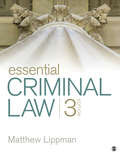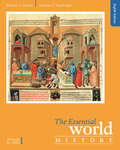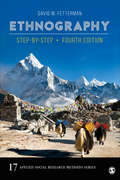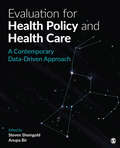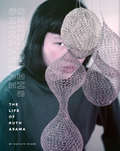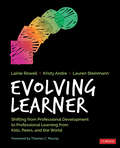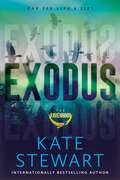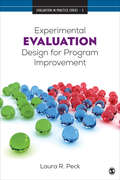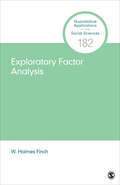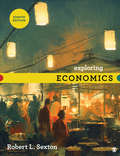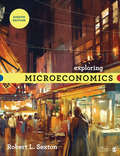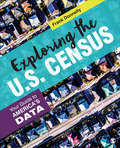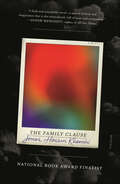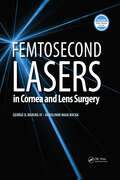- Table View
- List View
Essential Criminal Law
by Matthew LippmanEssential Criminal Law provides a highly accessible introduction to U.S. criminal law that helps students, including those with no prior exposure to case law, build their legal reasoning skills. Drawing from more than 30 years of teaching experience, best-selling author Matthew Lippman guides readers through the complexities of the legal system using thought-provoking examples of real-life crimes and legal defenses, along with approachable case analyses. The Third Edition keep readers up to date with coverage of timely topics and the most current developments in criminal law and public policy.
The Essential World History: Volume I: To 1800
by William J. Duiker Jackson J. SpielvogelExplore world history in a brief, balanced, highly readable overview that examines common challenges and experiences that unite the human past and identify key global regional patterns over time with THE ESSENTIAL WORLD HISTORY. This brief overview of world history covers political, economic, social, religious, intellectual, cultural, and military history integrated into a chronologically ordered synthesis to help you gain an appreciation and understanding of the distinctive character and development of individual cultures in society. You can use the book's global approach and its emphasis on analytical comparisons between cultures to link events together in a broad comparative and global framework that places the contemporary world in a more meaningful historical context.
Ethnography: Step-by-Step (Applied Social Research Methods #17)
by David FettermanDavid M. Fetterman captures the ethnographic imagination with the Fourth Edition of his popular text, Ethnography: Step-by-Step. He shares new case examples of his work to highlight the illuminating power of reflexivity and theory. The new edition expands the discussion of critical concepts such as culture, contextualization, emic and etic distinctions, and symbols. The book provides insights into the use of technology in ethnography from qualitative data analysis software to data visualization, and Questions for Reflection have been added to the end of each chapter. Fetterman is a seasoned educator, evidenced by both the clarity of his thinking and the simplicity of his writing.
Ethnography: Step-by-Step (Applied Social Research Methods #17)
by David FettermanDavid M. Fetterman captures the ethnographic imagination with the Fourth Edition of his popular text, Ethnography: Step-by-Step. He shares new case examples of his work to highlight the illuminating power of reflexivity and theory. The new edition expands the discussion of critical concepts such as culture, contextualization, emic and etic distinctions, and symbols. The book provides insights into the use of technology in ethnography from qualitative data analysis software to data visualization, and Questions for Reflection have been added to the end of each chapter. Fetterman is a seasoned educator, evidenced by both the clarity of his thinking and the simplicity of his writing.
Evaluation for Health Policy and Health Care: A Contemporary Data-Driven Approach
by Anupa Bir Steven SheingoldThis is the contemporary, applied text on evaluation that your students need. Evaluation for Health Policy and Health Care: A Contemporary Data-Driven Approach explores the best practices and applications for producing, synthesizing, visualizing, using, and disseminating health care evaluation research and reports. This graduate-level text will appeal to those interested in cutting-edge health program and health policy evaluation in this era of health care innovation. Editors Steven Sheingold and Anupa Bir’s core text focuses on quantitative, qualitative, and meta-analytic approaches to analysis, providing a guide for both those executing evaluations and those using the data to make policy decisions. It is designed to provide real-world applications within health policy to make learning more accessible and relevant, and to highlight the remaining challenges for using evidence to develop policy.
Evaluation for Health Policy and Health Care: A Contemporary Data-Driven Approach
by Anupa Bir Steven SheingoldThis is the contemporary, applied text on evaluation that your students need. Evaluation for Health Policy and Health Care: A Contemporary Data-Driven Approach explores the best practices and applications for producing, synthesizing, visualizing, using, and disseminating health care evaluation research and reports. This graduate-level text will appeal to those interested in cutting-edge health program and health policy evaluation in this era of health care innovation. Editors Steven Sheingold and Anupa Bir’s core text focuses on quantitative, qualitative, and meta-analytic approaches to analysis, providing a guide for both those executing evaluations and those using the data to make policy decisions. It is designed to provide real-world applications within health policy to make learning more accessible and relevant, and to highlight the remaining challenges for using evidence to develop policy.
Everything She Touched: Life of Ruth Asawa
by Marilyn ChaseEverything She Touched recounts the incredible life of the American sculptor Ruth Asawa.This is the story of a woman who wielded imagination and hope in the face of intolerance and who transformed everything she touched into art. In this compelling biography, author Marilyn Chase brings Asawa's story to vivid life. She draws on Asawa's extensive archives and weaves together many voices—family, friends, teachers, and critics—to offer a complex and fascinating portrait of the artist. Born in California in 1926, Ruth Asawa grew from a farmer's daughter to a celebrated sculptor. She survived adolescence in the World War II Japanese-American internment camps and attended the groundbreaking art school at Black Mountain College. Asawa then went on to develop her signature hanging-wire sculptures, create iconic urban installations, revolutionize arts education in her adopted hometown of San Francisco, fight through lupus, and defy convention to nurture a multiracial family.• A richly visual volume with over 60 reproductions of Asawa's art and archival photos of her life (including portraits shot by her friend, the celebrated photographer Imogen Cunningham)• Documents Asawa's transformative touch—most notably by turning wire – the material of the internment camp fences – into sculptures• Author Marilyn Chase mined Asawa's letters, diaries, sketches, and photos and conducted interviews with those who knew her to tell this inspiring story.Ruth Asawa forged an unconventional path in everything she did—whether raising a multiracial family of six children, founding a high school dedicated to the arts, or pursuing her own practice independent of the New York art market. Her beloved fountains are now San Francisco icons, and her signature hanging-wire sculptures grace the MoMA, de Young, Getty, Whitney, and many more museums and galleries across America.• Ruth Asawa's remarkable life story offers inspiration to artists, art lovers, feminists, mothers, teachers, Asian Americans, history buffs, and anyone who loves a good underdog story. • A perfect gift for those interested in Asian American culture and history • Great for those who enjoyed Ninth Street Women: Lee Krasner, Elaine de Kooning, Grace Hartigan, Joan Mitchell, and Helen Frankenthaler: Five Painters and the Movement That Changed Modern Art by Mary Gabriel, Ruth Asawa: Life's Work by Tamara Schenkenberg, and Notes and Methods by Hilma af Klint
Evocative Coaching: Transforming Schools One Conversation at a Time
by Megan Tschannen-Moran Robert K. Tschannen-MoranCultivate emotional intelligence and eliminate barriers to coaching success Challenging times demand we change how we teach, and research shows that coaching is the best way to bring about robust change in instructional practice. The second edition of Evocative Coaching helps skillful coaches develop trust and unearth the values and fears that both motivate and block teachers from achieving all that they hope. Using the LEAD (listen, emphasize, appreciate, and design) process, Evocative Coaches take a partnership role, ask questions, and co-create designs. This person-centered, no-fault, strengths-based model is grounded in adult learning theory and positive psychology and emphasizes the emotional intelligence needed to establish trust. The hands-on guide for coaching practitioners works with other coaching models and · is grounded in extensive research · includes real-life vignettes and sample dialogues that bring important principles to life · provides tools designed to invite reflection and help coaches continuously improve With evocative coaching, educators can rise to new heights of ambition and ability and discover new solutions to the complex challenges they face.
Evocative Coaching: Transforming Schools One Conversation at a Time
by Megan Tschannen-Moran Robert K. Tschannen-MoranCultivate emotional intelligence and eliminate barriers to coaching success Challenging times demand we change how we teach, and research shows that coaching is the best way to bring about robust change in instructional practice. The second edition of Evocative Coaching helps skillful coaches develop trust and unearth the values and fears that both motivate and block teachers from achieving all that they hope. Using the LEAD (listen, emphasize, appreciate, and design) process, Evocative Coaches take a partnership role, ask questions, and co-create designs. This person-centered, no-fault, strengths-based model is grounded in adult learning theory and positive psychology and emphasizes the emotional intelligence needed to establish trust. The hands-on guide for coaching practitioners works with other coaching models and · is grounded in extensive research · includes real-life vignettes and sample dialogues that bring important principles to life · provides tools designed to invite reflection and help coaches continuously improve With evocative coaching, educators can rise to new heights of ambition and ability and discover new solutions to the complex challenges they face.
Evolving Learner: Shifting From Professional Development to Professional Learning From Kids, Peers, and the World
by Lainie Jae Rowell Kristy J. Andre Lauren SteinmannLearn from Kids, Peers, and the World to Transform Professional Learning What can kids teach us about educational practices? It turns out, plenty. PD is evolving into professional learning (PL), where personalized experiences focus on goals and outcomes, rather than seat time. In Evolving Learner, successful PL is framed through three critical sources: learning from kids, from peers, and from the world. Woven throughout the book are tangible connections to cycles of inquiry where a harmonious balance is the ultimate goal when students are engaged in inquiry for deeper learning and teachers are engaged in a parallel process to improve their practice. The authors’ unique framework shifts away from factory model "PD" and transforms it into experiences tailored to kids’ and adult learners’ specific needs. Clear strategies for accomplishing PL are presented through A framework where both students and teachers are active agents of learning Cycles of inquiry to empower students to become the owners of learning Techniques to make thinking visible for teachers and students Cutting edge coverage of applying technology to professional learning including the use of social media, gamification, and digital badges The time is right to reclaim ownership of your professional learning: Evolving Learner is an essential guide for embarking on this journey.
Evolving Learner: Shifting From Professional Development to Professional Learning From Kids, Peers, and the World
by Lainie Jae Rowell Kristy J. Andre Lauren SteinmannLearn from Kids, Peers, and the World to Transform Professional Learning What can kids teach us about educational practices? It turns out, plenty. PD is evolving into professional learning (PL), where personalized experiences focus on goals and outcomes, rather than seat time. In Evolving Learner, successful PL is framed through three critical sources: learning from kids, from peers, and from the world. Woven throughout the book are tangible connections to cycles of inquiry where a harmonious balance is the ultimate goal when students are engaged in inquiry for deeper learning and teachers are engaged in a parallel process to improve their practice. The authors’ unique framework shifts away from factory model "PD" and transforms it into experiences tailored to kids’ and adult learners’ specific needs. Clear strategies for accomplishing PL are presented through A framework where both students and teachers are active agents of learning Cycles of inquiry to empower students to become the owners of learning Techniques to make thinking visible for teachers and students Cutting edge coverage of applying technology to professional learning including the use of social media, gamification, and digital badges The time is right to reclaim ownership of your professional learning: Evolving Learner is an essential guide for embarking on this journey.
Exciting Times: Longlisted for the Women's Prize for Fiction 2021
by Naoise Dolan'The book of the summer ... Kept me rapt until the final page' THE TIMES'A sharp, smart, witty modern love story. I loved it' David Nicholls, author of ONE DAY'More than lives up to the hype ... Likely to fill the Sally-Rooney-shaped hole in many readers' lives' IRISH TIMES'Droll, shrewd and unafraid - a winning debut' Hilary Mantel, author of WOLF HALL'I've been pushing Exciting Times on everyone I know. Some of Dolan's pithy observations of her characters are the best I've read since Edward St Aubyn' OBSERVER'A frankly sensational book' Pandora Sykes on THE HIGH LOW'In the tradition of Dorothy Parker, Joan Rivers and Nora Ephron ... I found myself purring with pleasure. ...This is comic writing at the highest level' Craig Brown, DAILY MAILWhen you leave Ireland aged 22 to spend your parents' money, it's called a gap year. When Ava leaves Ireland aged 22 to make her own money, she's not sure what to call it, but it involves:- a badly-paid job in Hong Kong, teaching English grammar to rich children;- Julian, who likes to spend money on Ava and lets her move into his guest room;- Edith, who Ava meets while Julian is out of town and actually listens to her when she talks;- money, love, cynicism, unspoken feelings and unlikely connections.Exciting times ensue.
Exodus (The Ravenhood #2)
by Kate StewartFor fans of Lauren Asher, Penelope Douglas, and Ana Huang, the continuation of Tiktok phenom Kate Stewart&’s internationally bestselling Ravenhood trilogy, a deliciously steamy, irresistibly edgy and suspenseful Robin Hood retelling that offers a thoroughly unique modern-day spin on the original brotherhood of morally gray bad boys.Can you live a lie? It&’s a ghost town, this place that haunts me, the one that made me. It&’s clear to me that I&’ll never outgrow Triple Falls or outlive the time I spent here.I can still feel them all, my boys of summer.Even when I&’d sensed the danger, I gave in. I didn&’t heed a single warning. I let my sickness, my love, both rule and ruin me. I played my part, eyes wide open, tempting fate until it delivered. There was never going to be an escape.All of us are to blame for what happened. All of us serving our own sentences. We were careless and reckless, thinking our youth made us indestructible, exempt from our sins, and it cost us all.I&’m done pretending I didn&’t leave the largest part of me between these hills and valleys, between the sea of trees that hold my secrets.It&’s the reason I&’m back. To make peace with my fate. And if I can&’t grieve enough to cure myself in my time here, I&’ll remain sick. That will be my curse.But it&’s time to confess, to myself more so than any other, that I&’d hindered my chances because of the way I was built, and because of the men who built me.At this point, I just want to make peace with who I am, no matter what ending I get. Because I can no longer live a lie.
Experimental Evaluation Design for Program Improvement (Evaluation in Practice Series #5)
by Laura R. PeckThe concepts of cause and effect are critical to the field of program evaluation. Experimentally-designed evaluations—those that randomize to treatment and control groups—offer a convincing means for establishing a causal connection between a program and its effects. Experimental Evaluation Design for Program Improvement considers a range of impact evaluation questions, particularly those questions that focus on the impact of specific aspects of a program. Laura R. Peck shows how a variety of experimental evaluation design options can provide answers to these questions, and she suggests opportunities for experiments to be applied in more varied settings and focused on program improvement efforts.
Experimental Evaluation Design for Program Improvement (Evaluation in Practice Series #5)
by Laura R. PeckThe concepts of cause and effect are critical to the field of program evaluation. Experimentally-designed evaluations—those that randomize to treatment and control groups—offer a convincing means for establishing a causal connection between a program and its effects. Experimental Evaluation Design for Program Improvement considers a range of impact evaluation questions, particularly those questions that focus on the impact of specific aspects of a program. Laura R. Peck shows how a variety of experimental evaluation design options can provide answers to these questions, and she suggests opportunities for experiments to be applied in more varied settings and focused on program improvement efforts.
Exploratory Factor Analysis (Quantitative Applications in the Social Sciences #182)
by Holmes FinchA firm knowledge of factor analysis is key to understanding much published research in the social and behavioral sciences. Exploratory Factor Analysis by W. Holmes Finch provides a solid foundation in exploratory factor analysis (EFA), which along with confirmatory factor analysis, represents one of the two major strands in this field. The book lays out the mathematical foundations of EFA; explores the range of methods for extracting the initial factor structure; explains factor rotation; and outlines the methods for determining the number of factors to retain in EFA. The concluding chapter addresses a number of other key issues in EFA, such as determining the appropriate sample size for a given research problem, and the handling of missing data. It also offers brief introductions to exploratory structural equation modeling, and multilevel models for EFA. Example computer code, and the annotated output for all of the examples included in the text are available on an accompanying website.
Exploratory Factor Analysis (Quantitative Applications in the Social Sciences #182)
by Holmes FinchA firm knowledge of factor analysis is key to understanding much published research in the social and behavioral sciences. Exploratory Factor Analysis by W. Holmes Finch provides a solid foundation in exploratory factor analysis (EFA), which along with confirmatory factor analysis, represents one of the two major strands in this field. The book lays out the mathematical foundations of EFA; explores the range of methods for extracting the initial factor structure; explains factor rotation; and outlines the methods for determining the number of factors to retain in EFA. The concluding chapter addresses a number of other key issues in EFA, such as determining the appropriate sample size for a given research problem, and the handling of missing data. It also offers brief introductions to exploratory structural equation modeling, and multilevel models for EFA. Example computer code, and the annotated output for all of the examples included in the text are available on an accompanying website.
Exploring Economics: Exploring Economics, 6th + Aplia 1-semester Instant Access
by Robert L. SextonThe excitement of learning economics for the first time. The experience of a lifetime of teaching it. The Eighth Edition of Exploring Economics captures the excitement of learning economics for the first time through a lively and encouraging narrative that connects economics to the world in a way that is familiar to students. Author Robert L. Sexton draws on over 25 years of teaching experience to capture students’ attention, focusing on core concepts and expertly weaving in examples from current events and popular culture to make even classic economic principles modern and relatable. The text sticks to the basics and applies a thoughtful learning design, segmenting its presentation into brief, visually appealing, self-contained sections that are easier for students to digest and retain compared to sprawling text. Thoughtfully placed section quizzes, interactive summaries, and problem sets help students check their comprehension at regular intervals and develop the critical thinking skills that will allow them to "think like economists." Combined with a complete teaching and learning package, Exploring Economics is sure to help you ignite your students’ passion for the field and reveal its practical application in the world around them.
Exploring Economics: Exploring Economics, 6th + Aplia 1-semester Instant Access
by Robert L. SextonThe excitement of learning economics for the first time. The experience of a lifetime of teaching it. The Eighth Edition of Exploring Economics captures the excitement of learning economics for the first time through a lively and encouraging narrative that connects economics to the world in a way that is familiar to students. Author Robert L. Sexton draws on over 25 years of teaching experience to capture students’ attention, focusing on core concepts and expertly weaving in examples from current events and popular culture to make even classic economic principles modern and relatable. The text sticks to the basics and applies a thoughtful learning design, segmenting its presentation into brief, visually appealing, self-contained sections that are easier for students to digest and retain compared to sprawling text. Thoughtfully placed section quizzes, interactive summaries, and problem sets help students check their comprehension at regular intervals and develop the critical thinking skills that will allow them to "think like economists." Combined with a complete teaching and learning package, Exploring Economics is sure to help you ignite your students’ passion for the field and reveal its practical application in the world around them.
Exploring Microeconomics: Pathways To Problem Solving
by Robert L. SextonThe excitement of learning economics for the first time. The experience of a lifetime of teaching it. The Eighth Edition of Exploring Microeconomics captures the excitement of learning microeconomics for the first time through a lively and encouraging narrative that connects microeconomics to the world in a way that is familiar to students. Author Robert L. Sexton draws on over 25 years of teaching experience to capture students’ attention, focusing on core concepts and expertly weaving in examples from current events and popular culture to make even classic economic principles modern and relatable. The text sticks to the basics and applies a thoughtful learning design, segmenting its presentation into brief, visually appealing, self-contained sections that are easier for students to digest and retain compared to sprawling text. Thoughtfully placed section quizzes, interactive summaries, and problem sets help students check their comprehension at regular intervals and develop the critical thinking skills that will allow them to "think like economists." Combined with a complete teaching and learning package, Exploring Microeconomics is sure to help you ignite your students’ passion for the field and reveal its practical application in the world around them.
Exploring Microeconomics: Pathways To Problem Solving
by Robert L. SextonThe excitement of learning economics for the first time. The experience of a lifetime of teaching it. The Eighth Edition of Exploring Microeconomics captures the excitement of learning microeconomics for the first time through a lively and encouraging narrative that connects microeconomics to the world in a way that is familiar to students. Author Robert L. Sexton draws on over 25 years of teaching experience to capture students’ attention, focusing on core concepts and expertly weaving in examples from current events and popular culture to make even classic economic principles modern and relatable. The text sticks to the basics and applies a thoughtful learning design, segmenting its presentation into brief, visually appealing, self-contained sections that are easier for students to digest and retain compared to sprawling text. Thoughtfully placed section quizzes, interactive summaries, and problem sets help students check their comprehension at regular intervals and develop the critical thinking skills that will allow them to "think like economists." Combined with a complete teaching and learning package, Exploring Microeconomics is sure to help you ignite your students’ passion for the field and reveal its practical application in the world around them.
Exploring the U.S. Census: Your Guide to America’s Data
by Francis P. DonnellyExploring the U.S. Census gives social science students and researchers alike the tools to understand, extract, process, and analyze data from the decennial census, the American Community Survey, and other data collected by the U.S. Census Bureau. Donnelly′s text provides a thorough background on the data collection methods, structures, and potential pitfalls of the census for unfamiliar researchers, collecting information previously available only in widely disparate sources into one handy guide. Hands-on, applied exercises at the end of the chapters help readers dive into the data. Along the way, the author shows how best to analyze census data with open-source software and tools. Readers can freely evaluate the data on their own computers, in keeping with the free and open data provided by the Census Bureau. By placing the census in the context of the open data movement, this text makes the history and practice of the census relevant so readers can understand what a crucial resource the census is for research and knowledge.
Exploring the U.S. Census: Your Guide to America’s Data
by Francis P. DonnellyExploring the U.S. Census gives social science students and researchers alike the tools to understand, extract, process, and analyze data from the decennial census, the American Community Survey, and other data collected by the U.S. Census Bureau. Donnelly′s text provides a thorough background on the data collection methods, structures, and potential pitfalls of the census for unfamiliar researchers, collecting information previously available only in widely disparate sources into one handy guide. Hands-on, applied exercises at the end of the chapters help readers dive into the data. Along the way, the author shows how best to analyze census data with open-source software and tools. Readers can freely evaluate the data on their own computers, in keeping with the free and open data provided by the Census Bureau. By placing the census in the context of the open data movement, this text makes the history and practice of the census relevant so readers can understand what a crucial resource the census is for research and knowledge.
The Family Clause: A Novel
by Jonas Hassen Khemiri“The son did as he was told. All his bloody life, he has done as he has been told. Time to change that, he thinks, grabbing a pen. He doesn’t write that this will be the last time his father stays here. He doesn’t write that he wants to break the father clause. Instead, he writes: Welcome, Dad. Hope you had a good flight.”A grandfather who lives abroad returns home to visit his adult children. The son is a failure. The daughter is having a baby with the wrong man. Only the grandfather is perfect—at least, according to himself. But over the course of ten intense days, relationships unfold and painful memories resurface. The grandfather is confronted by his past. The daughter is faced with an impossible choice. The son tries to write himself free. Something has to give. Per a longstanding family agreement, the grandfather has maintained his Swedish residency by coming to stay with his son every six months. Can this clause be renegotiated, or will it chain the family to its past forever?Through a series of quickly changing perspectives, in The Family Clause Jonas Hassen Khemiri evokes an intimate portrait of a chaotic and perfectly normal family, deeply wounded by the death of a child and the disappearance of a father.
Femtosecond Lasers in Cornea and Lens Surgery
by George Waring Karolinne RochaFor ophthalmologists who are already using femtosecond lasers as well as those just starting out who are looking for the definitive reference manual, Femtosecond Lasers in Cornea and Lens Surgery is a comprehensive, cutting-edge guide to this technology that features a robust supplemental website with nearly 40 surgical videos. With the advent of small incision lenticule extraction, pockets and channels for corneal inlays and ring segments, femtosecond lasers for corneal surgery have advanced significantly over the past several decades, and ophthalmologists are looking for expert guidance on their acquisition, utilization, and optimization. With contributions from world-renowned surgeons who have seen the benefit of integrating femtosecond laser technology into their practices, this text reviews the practical aspects of femtosecond technology and also addresses the future of this quickly evolving space. Drs. George O. Waring, IV and Karolinne Maia Rocha lead their team of more than 50 expert contributors in providing a thorough, definitive text summarizing all aspects of femtosecond lasers for corneal and lens surgery in a balanced and commercially unbiased manner. All of the major platforms and systems are covered in chapters including: Integration of Femtosecond Laser–Assisted Cataract Surgery Into Your Practice Therapeutic Laser Assisted Cataract Surgery Complications of Femtosecond LASIK Small Incision Lenticule Extraction Femtosecond Laser Pockets for Corneal Inlays Use of Femtosecond Lasers in Keratoplasty For a comprehensive resource on the use of femtosecond lasers in cornea and lens surgery, as well as unbiased opinions from expert contributors on the various procedures and platforms, Femtosecond Lasers in Cornea and Lens Surgery is a must-have for ophthalmologists wishing to stay on top of this evolving field.
